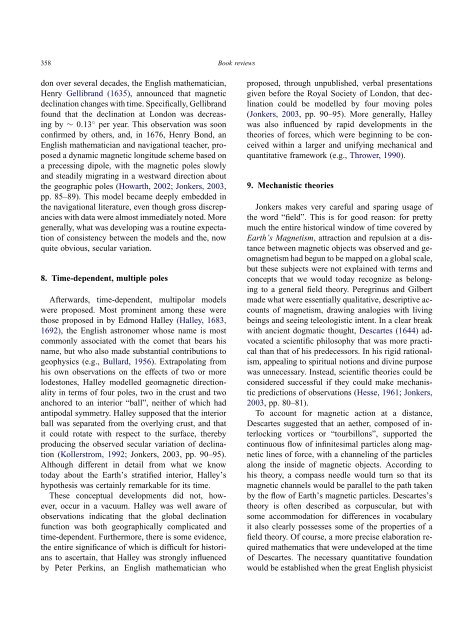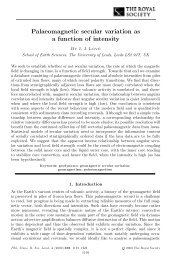Earth's Magnetism in the Age of Sail - USGS Geomagnetism Program
Earth's Magnetism in the Age of Sail - USGS Geomagnetism Program
Earth's Magnetism in the Age of Sail - USGS Geomagnetism Program
You also want an ePaper? Increase the reach of your titles
YUMPU automatically turns print PDFs into web optimized ePapers that Google loves.
358 Book reviewsdon over several decades, <strong>the</strong> English ma<strong>the</strong>matician,Henry Gellibrand (1635), announced that magneticdecl<strong>in</strong>ation changes with time. Specifically, Gellibrandfound that <strong>the</strong> decl<strong>in</strong>ation at London was decreas<strong>in</strong>gby ∼ 0.13 ◦ per year. This observation was soonconfirmed by o<strong>the</strong>rs, and, <strong>in</strong> 1676, Henry Bond, anEnglish ma<strong>the</strong>matician and navigational teacher, proposeda dynamic magnetic longitude scheme based ona precess<strong>in</strong>g dipole, with <strong>the</strong> magnetic poles slowlyand steadily migrat<strong>in</strong>g <strong>in</strong> a westward direction about<strong>the</strong> geographic poles (Howarth, 2002; Jonkers, 2003,pp. 85–89). This model became deeply embedded <strong>in</strong><strong>the</strong> navigational literature, even though gross discrepancieswith data were almost immediately noted. Moregenerally, what was develop<strong>in</strong>g was a rout<strong>in</strong>e expectation<strong>of</strong> consistency between <strong>the</strong> models and <strong>the</strong>, nowquite obvious, secular variation.8. Time-dependent, multiple polesAfterwards, time-dependent, multipolar modelswere proposed. Most prom<strong>in</strong>ent among <strong>the</strong>se werethose proposed <strong>in</strong> by Edmond Halley (Halley, 1683,1692), <strong>the</strong> English astronomer whose name is mostcommonly associated with <strong>the</strong> comet that bears hisname, but who also made substantial contributions togeophysics (e.g., Bullard, 1956). Extrapolat<strong>in</strong>g fromhis own observations on <strong>the</strong> effects <strong>of</strong> two or morelodestones, Halley modelled geomagnetic directionality<strong>in</strong> terms <strong>of</strong> four poles, two <strong>in</strong> <strong>the</strong> crust and twoanchored to an <strong>in</strong>terior “ball”, nei<strong>the</strong>r <strong>of</strong> which hadantipodal symmetry. Halley supposed that <strong>the</strong> <strong>in</strong>teriorball was separated from <strong>the</strong> overly<strong>in</strong>g crust, and thatit could rotate with respect to <strong>the</strong> surface, <strong>the</strong>rebyproduc<strong>in</strong>g <strong>the</strong> observed secular variation <strong>of</strong> decl<strong>in</strong>ation(Kollerstrom, 1992; Jonkers, 2003, pp. 90–95).Although different <strong>in</strong> detail from what we knowtoday about <strong>the</strong> Earth’s stratified <strong>in</strong>terior, Halley’shypo<strong>the</strong>sis was certa<strong>in</strong>ly remarkable for its time.These conceptual developments did not, however,occur <strong>in</strong> a vacuum. Halley was well aware <strong>of</strong>observations <strong>in</strong>dicat<strong>in</strong>g that <strong>the</strong> global decl<strong>in</strong>ationfunction was both geographically complicated andtime-dependent. Fur<strong>the</strong>rmore, <strong>the</strong>re is some evidence,<strong>the</strong> entire significance <strong>of</strong> which is difficult for historiansto ascerta<strong>in</strong>, that Halley was strongly <strong>in</strong>fluencedby Peter Perk<strong>in</strong>s, an English ma<strong>the</strong>matician whoproposed, through unpublished, verbal presentationsgiven before <strong>the</strong> Royal Society <strong>of</strong> London, that decl<strong>in</strong>ationcould be modelled by four mov<strong>in</strong>g poles(Jonkers, 2003, pp. 90–95). More generally, Halleywas also <strong>in</strong>fluenced by rapid developments <strong>in</strong> <strong>the</strong><strong>the</strong>ories <strong>of</strong> forces, which were beg<strong>in</strong>n<strong>in</strong>g to be conceivedwith<strong>in</strong> a larger and unify<strong>in</strong>g mechanical andquantitative framework (e.g., Thrower, 1990).9. Mechanistic <strong>the</strong>oriesJonkers makes very careful and spar<strong>in</strong>g usage <strong>of</strong><strong>the</strong> word “field”. This is for good reason: for prettymuch <strong>the</strong> entire historical w<strong>in</strong>dow <strong>of</strong> time covered byEarth’s <strong>Magnetism</strong>, attraction and repulsion at a distancebetween magnetic objects was observed and geomagnetismhad begun to be mapped on a global scale,but <strong>the</strong>se subjects were not expla<strong>in</strong>ed with terms andconcepts that we would today recognize as belong<strong>in</strong>gto a general field <strong>the</strong>ory. Peregr<strong>in</strong>us and Gilbertmade what were essentially qualitative, descriptive accounts<strong>of</strong> magnetism, draw<strong>in</strong>g analogies with liv<strong>in</strong>gbe<strong>in</strong>gs and see<strong>in</strong>g teleologistic <strong>in</strong>tent. In a clear breakwith ancient dogmatic thought, Descartes (1644) advocateda scientific philosophy that was more practicalthan that <strong>of</strong> his predecessors. In his rigid rationalism,appeal<strong>in</strong>g to spiritual notions and div<strong>in</strong>e purposewas unnecessary. Instead, scientific <strong>the</strong>ories could beconsidered successful if <strong>the</strong>y could make mechanisticpredictions <strong>of</strong> observations (Hesse, 1961; Jonkers,2003, pp. 80–81).To account for magnetic action at a distance,Descartes suggested that an ae<strong>the</strong>r, composed <strong>of</strong> <strong>in</strong>terlock<strong>in</strong>gvortices or “tourbillons”, supported <strong>the</strong>cont<strong>in</strong>uous flow <strong>of</strong> <strong>in</strong>f<strong>in</strong>itesimal particles along magneticl<strong>in</strong>es <strong>of</strong> force, with a channel<strong>in</strong>g <strong>of</strong> <strong>the</strong> particlesalong <strong>the</strong> <strong>in</strong>side <strong>of</strong> magnetic objects. Accord<strong>in</strong>g tohis <strong>the</strong>ory, a compass needle would turn so that itsmagnetic channels would be parallel to <strong>the</strong> path takenby <strong>the</strong> flow <strong>of</strong> Earth’s magnetic particles. Descartes’s<strong>the</strong>ory is <strong>of</strong>ten described as corpuscular, but withsome accommodation for differences <strong>in</strong> vocabularyit also clearly possesses some <strong>of</strong> <strong>the</strong> properties <strong>of</strong> afield <strong>the</strong>ory. Of course, a more precise elaboration requiredma<strong>the</strong>matics that were undeveloped at <strong>the</strong> time<strong>of</strong> Descartes. The necessary quantitative foundationwould be established when <strong>the</strong> great English physicist






